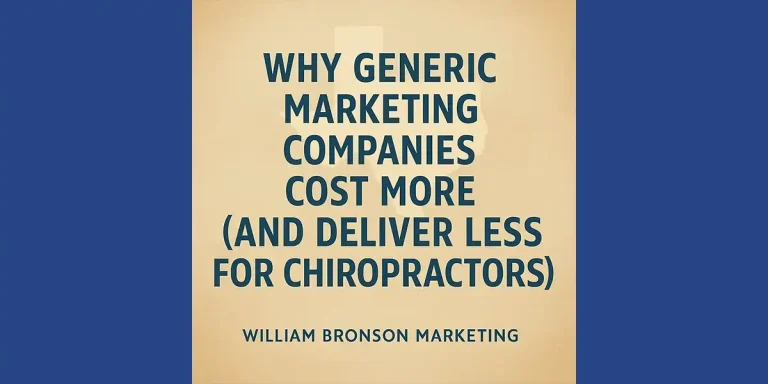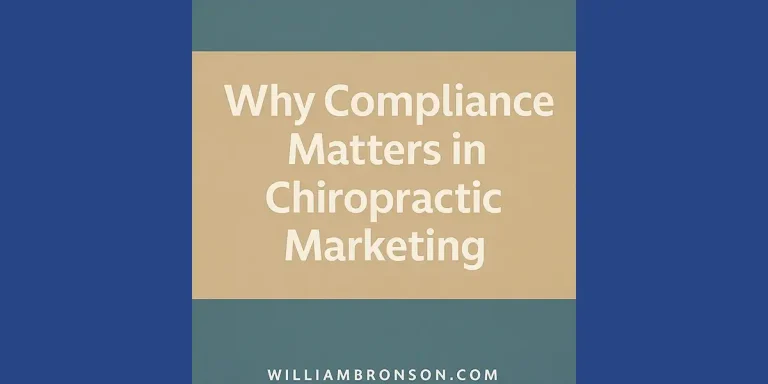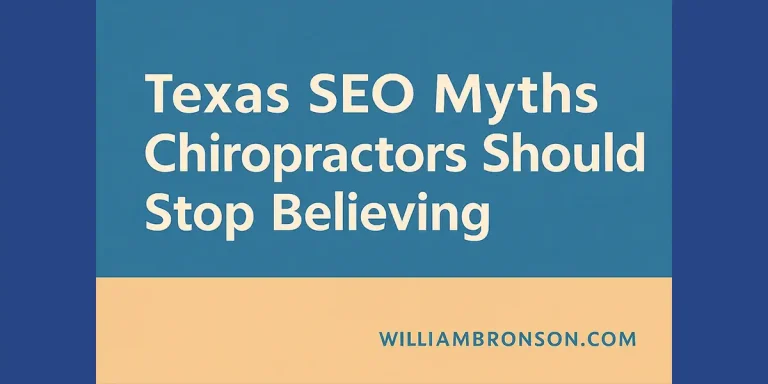How to Rank in Google Without Violating Texas Chiropractic Law
The YouTube Problem Nobody Talks About
You’ve probably seen the videos with millions of views, wild thumbnails, and captions like:
“Chiropractor Literally Rips Head Off Young Woman!”
Or the infamous “Ring Dinger” clips that promise miracle cures in a single adjustment.
They’re entertaining, sure. But if you’re a licensed chiropractor in Texas, those kinds of headlines should make your stomach drop. What plays well on YouTube can play terribly with the Texas Board of Chiropractic Examiners (TBCE).
I’ve spent years studying how digital platforms and regulations intersect, first in financial services, then in the insurance industry, and now with Texas chiropractic. And I’ll tell you this straight: shock value gets clicks, but compliance builds a career.
The goal isn’t to go viral; it’s to stay visible, trusted, and respected. Let’s talk about how to do that.
The Line Between Attention and Violation
Texas doesn’t ban chiropractors from marketing; it simply expects honesty and evidence.
Under Texas Administrative Code §77.1 and §77.4, you can’t make false, misleading, or unverifiable claims. And Texas Occupations Code §201.502(9) goes even further: any advertising that creates “a false or misleading impression” can be grounds for disciplinary action.
Here’s what that means in practice:
❌ No claims that you “cure,” “fix,” or “reverse” diseases
❌ No superiority language (“best chiropractor in Fort Worth”)
❌ No unverifiable testimonials (“changed my life instantly”)
❌ No misleading visuals that dramatize risk or pain
When chiropractors cross that line, even unintentionally, they risk both their license and their reputation.
And here’s the kicker: Google doesn’t reward exaggeration either. Its algorithms have matured far beyond keyword stuffing and hype. The same tactics that get you in trouble with the TBCE are the ones that make Google distrust your site.
What Google Actually Rewards (And It’s Not Shock Value)
Google’s entire search model is built around E-E-A-T — Experience, Expertise, Authoritativeness, and Trustworthiness.
In other words, Google’s bots think like your patients: they reward the pages that teach, not tease.
That’s good news for Texas chiropractors who play by the rules.
When your website explains what you do, why you do it, and how it helps within scope, you’re giving Google exactly what it wants: clarity, relevance, and authority.
Here’s how this plays out:
- A blog explaining how posture affects spinal health will outperform one making miracle cure claims.
- A page titled “Chiropractor in Azle, TX – Gentle Family Care” ranks higher and longer than “Back Pain Fixed in One Crack!”
- A consistent Google Business Profile, with compliant service descriptions and regular posts, builds both local SEO and patient trust.
Shock value might get attention for a week. Integrity builds traffic for years.
The Compliance-First SEO Formula for Texas Chiropractors
At Bronson Marketing, I teach a simple framework called Compliance-First SEO, because your digital marketing should never outrun your license.
Let’s break it down.
1. Educate Before You Advertise
The best chiropractic content doesn’t sell an adjustment — it explains it. Google ranks pages that answer patient questions:
- “What is a chiropractic adjustment?”
- “Can chiropractic care help with posture?”
- “What should I expect on my first visit?”
Each answer positions you as the expert in your community.
2. Use Your Town and Topics Naturally
Texas chiropractors thrive on local intent. Instead of chasing national keywords, dominate your ZIP code. Use phrases like:
“We help families in Azle and surrounding communities find gentle, natural relief.”
That’s authentic local SEO — and it doesn’t violate a single rule.
3. Replace “Claims” with “Insight”
You don’t need to say “chiropractic cures migraines.”
Instead, say:
“Many patients find that regular adjustments help improve mobility and reduce tension related to headaches.”
That one shift turns a risky claim into compliant education. And it sounds more credible.
4. Cite Credible Sources
When you back up your statements with references to the Texas Chiropractic Association, peer-reviewed studies, or public health data, you strengthen both SEO and trust.
Google loves outbound citations to reputable sources, and the TBCE loves accuracy.
5. Maintain Brand Consistency
Your website, Google Business Profile, and social media should sound like they belong to the same professional.
If your site says “gentle, family-based care,” don’t post shocking or exaggerated videos on TikTok. Mixed messaging erodes both trust and ranking authority. I can’t count how many times business owners have told me some of the very creative and attractive clickbait methods they recommended. Yes, they make people click. But no, they don’t enhance your image. Do you want to be a professional chiropractor, a healer, a trusted caregiver? Or, do you want to sell sneakers on TikTok? Choose wisely.
Real-World Example: From Viral to Valuable
Let’s look at a practical example.
Suppose someone uploads a video titled:
“Ring Dinger Miracle Cure for Back Pain”
That title might rack up views but it crosses multiple lines:
- It implies a “miracle cure” (unverifiable and misleading)
- It uses sensational language that trivializes spinal care.
- It potentially damages public perception of the profession.
Now, here’s how to make that same topic powerful and compliant:
“Gentle Spinal Adjustments for Long-Term Back Health in Fort Worth”
Same focus: spinal health.
Different framing: patient education and location-based relevance.
That single headline change:
- Improves local SEO (“Fort Worth” keyword)
- Strengthens E-E-A-T (educational intent)
- Protects you from advertising violations.
- Earns trust from the exact patients you want to attract.
You don’t have to be boring to be compliant, you just have to be honest.
Why Ethical Content Wins in the Long Game
Compliance isn’t about fear; it’s about freedom.
When you know your content meets every rule in the book, you can publish confidently, advertise consistently, and sleep soundly.
The chiropractors who win in Google search aren’t the ones shouting loudest; they’re the ones showing up week after week with content that teaches, uplifts, and builds trust.
Think about it like an adjustment for your marketing: small, consistent alignments over time produce the biggest change.
That’s why my entire approach to Texas chiropractic marketing is built around three principles:
- Trust first – Lead with patient education, not promotion.
- Compliance always – Avoid anything that could be read as false, deceptive, or unverifiable.
- Content compounding – Each blog, page, and post builds lasting visibility that paid ads can’t match.
Shock tactics fade. Ethical authority compounds.
How to Get Started
If you’re a Texas chiropractor ready to grow your practice without risking your license, here’s your roadmap:
- Audit your content – Are any pages making unverified claims?
- Check your consistency – Does your Google Business Profile match your website?
- Start publishing weekly – Focus on educational posts, FAQs, and local topics.
Google rewards activity and authenticity, not perfection.
And if you’d rather have a marketing partner who understands both SEO and the Texas Chiropractic Act, that’s where I come in.
Schedule a Compliant SEO Review
If you’re unsure where your content stands or you just want a fresh, compliant strategy, let’s talk.
I specialize in compliant SEO and content for Texas chiropractors, built on trust, ethics, and measurable results.
📞 Call (817) 382-1902 or email [email protected]
Let’s help your clinic rank higher, stay compliant, and earn the trust your work deserves.






